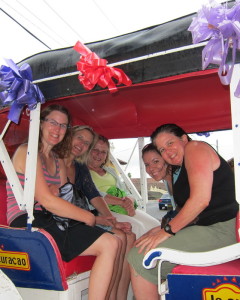Nicaragua 2012 trip diary: In a country this poor, every donation is appreciated
By Tina Romenesko
Friday morning. Our last day with the medical mission. The workload was lighter than expected as a group of 19 women, that we were hoping would arrive from a distant village, were unfortunately not going to be able to make the trip to the clinic. The interpreters were sent into the hallways to do patient education and do interviews assessing the level of knowledge patients had about health issues in general, and cervical cancer, specifically. Shannon was always able to get a smile from the kids and the adults with her bright effervescent personality. At 19, she is the youngest member of the DFW team, and by far the most energetic! By around 12:30, we were completely done with patients and were packing up the suitcases that organize the medical supplies, getting them ready for their next stop. Peru. Dr. Pam and her kids, and Carol were leaving for Lima the next morning for another PINCC mission.
The Nicaraguan staff of doctors and nurses plus Jenny had made plans to take both the PINCC group and DFW out to lunch to culminate our mission. We sat at the same large table where we’d eaten the night before. It was inspiring to see how the entire group had gelled. Spanglish was heard at all levels as we connected as colleagues outside of the confines of the hospital corridors. There were lots of snapshots and smiles and exchanging of email addresses. Dr. Pam addressed the group and offered her thanks to each and every one of us for our important role in preventing cervical cancer through education and training medical personnel. Five certificates of graduation were distributed amid rounds of applause and tears. The recipients varied from Ob-Gyns, to Family Practice Physicians, to nurses, and one nurse’s aid that had only completed an eighth grade level of education. What is particularly amazing about this screening method is that it can be performed by any trained medical personnel, which makes it much more sustainable in developing countries. We posed for our group picture in the restaurant garden, and said good-byes for another 15 minutes before finally dispersing the group. An amazing experience that has filled all of us with a deep sense of gratitude.
That evening we met for dinner in the hotel lobby and shared, again, some of the high and low points of the trip. I donated my headlamp to Carol – an essential piece of equipment in the VIAA process. Because of headlamps, clinics don’t need to have electricity to do screenings. She was thrilled, exclaiming that this headlamp would go to Antonia, the nurse’s aide that had just received her certification. We were also leaving our scrubs and various pieces of clothing from running shoes to t-shirts. “In a country this poor, every donation is appreciated,” explained Carol.
A few of us rounded up the evening at Via Via, just around the corner from our hotel, dancing to the rhythm of a local salsa band. Tomorrow we head for Managua.

